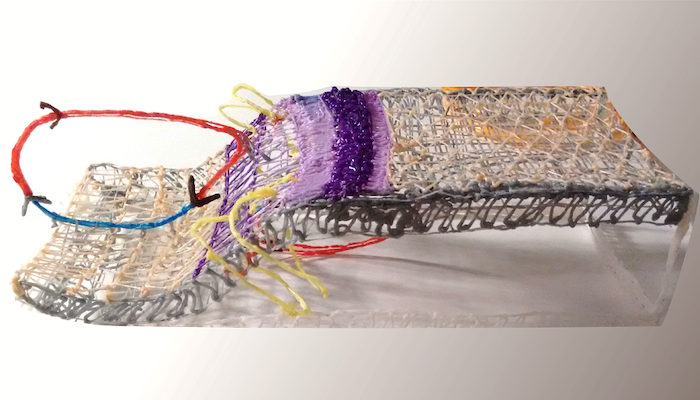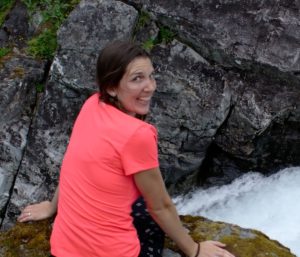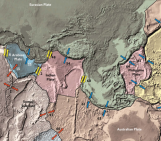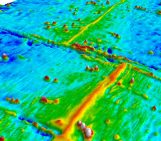

Ági Kiraly. Credit: Ági Kiraly
Ágnes Király is a postdoctoral research fellow at the Centre of Earth Evolution and Dynamics (CEED) at the University of Oslo, Norway. Ági has a background in geophysics, incorporating natural observations with numerical and analog models to study subduction zone processes. Ági has simulated subduction systems mostly in the Central Mediterranean.
Working this spring will probably be somewhat different; no commute to work, maybe kids taking some of our attention, but no colleagues knocking on the office door, preparing and giving online lectures, attending online conferences. The list goes on… For some, the most difficult of all: no access to laboratories to proceed with our experiments, to work away from our desks, to get that essential data for our next (online) conference.
Analog models have been an important part of geosciences for over two centuries, and I would argue that they should remain to be so. It all started when a Scottish geologist, Sir James Hall (Ranalli, 2001), used a box model with layers of clay that he squeezed to represent how folds are created in an outcrop. Although his study was purely qualitative, it became an example for many small scale studies on fault propagation, thrusting and folding (Schellart and Strak, 2016). In the 1930’s a more quantitative approach progressed the analog modeling world, using proper scaling between natural and laboratory processes to ensure geometric, kinematic and dynamic similarities (Hubbert, 1937). Our thinking about how the Earth works and the technology we can use to study it has changed enormously since then.
Technological advances have allowed numerical models to become a primary tool of geodynamics. The increasing computational capacity allowed for increasing model sizes and resolutions to solve complex problems. But with great power comes great responsibility. Results of numerical models can be affected by numerical errors and sometimes the wrong underlying physics. The advantage of analog models is that they happen naturally, and if the scaling is meaningful, they have the same underlying physics as the naturally occurring processes. Hence, analog models are now often used to benchmark numerical models. I personally think, that analog models have many advantages: it’s easy to change and test different geometries, they help to find scaling laws for processes where the underlying physics are not completely understood (which is needed to model them numerically), and most importantly, we observe them physically, not just through a set of numbers. The last point is the one I really wanted to talk about here.
As a student in geophysics, I was amazed by the world of geodynamics. In every class we had something exciting to learn, and sometimes simple concepts could explain so many things. For example I could not imagine how a subduction zone worked until I had a chance to go to the Laboratory of Experimental Tectonics at Uni Roma TRE. By simplifying the problem, preparing the materials, and then running a subduction experiment, I learnt to understand the relationship between the lithosphere and the mantle, and how one affects the other. Particularly, I learnt a lot by picturing the previously enigmatic poloidal and toroidal flow around the slab (Figure 1).

Fig.1 Poloidal mantle flow around slab tips in an outward-dipping double-sided subduction setting (Király et al., 2018).
After seeing subduction live, I could relate to the problem when we calculated the forces in a subduction zone in the classroom. As a PhD student at Roma Tre, I have seen a large variety of analog models, which made me appreciate the complexity of nature and have a better picture in my head about many physical phenomena on Earth. Doing experiments may be laborious for teachers and professors, but it is truly a great way to engage and excite students about geodynamics and tectonics and to prepare them for field work (Steyrer, 2009).
Lastly, some tips on how to occupy your kids and students while at home:
- Test the bending and coiling of honey: It has been shown that the way a viscous fluid bends on a surface depends on its viscosity and the height of falling (Ribe, 2004). Easy to try and lots to learn!
- Plate tectonics in a pan: Heat milk in a pan and put a thick layer of cocoa on top. Great fun for kids
- Observe your coffee (‘Rayleigh-Taylor instability – Physics Blog’, no date): Do you also get amazed how beautiful it is when your coffee mixes with hot milk. If you are a physicist or geodynamicist you will realize that the beautiful pattern is the result of a Rayleigh-Taylor instability, where a denser fluid (e.g. lithospheric mantle or milk) is on top of a less dense fluid (e.g. asthenosphere or coffee).
- Extension of a layered crust: I remember seeing this at a conference, where the authors used a Mars bar as analog for the layered crust in extension.
- Salt tectonics using dish soap and sand.
- And of course, never forget about Oreo tectonics (Lillie, 2004):

Edited by Derya Gürer
References
Hubbert, M. K. (1937) ‘Theory of scale models as applied to the study of geologic structures’, Bulletin of the Geological Society of America, 48, pp. 1459–1520.
Király, Á. et al. (2018) ‘Modeling Slab-Slab Interactions: Dynamics of Outward Dipping Double-Sided Subduction Systems’, Geochemistry, Geophysics, Geosystems, 19(3), pp. 693–714. doi: 10.1002/2017GC007199.
Lillie, R. J. (2004) ‘FUN WITH FOOD! PLATE TECTONICS AND OUR NATIONAL PARKS’, p. 4.
Ranalli, G. (2001) ‘Experimental tectonics: from Sir James Hall to the present’, Journal of Geodynamics, 32(1), pp. 65–76. doi: 10.1016/S0264-3707(01)00023-0.
‘Rayleigh-Taylor instability – Physics Blog’ (no date). Available at: https://physics.blogberth.com/category/rayleigh-taylor-instability/ (Accessed: 20 April 2020).
Ribe, N. M. (2004) ‘Coiling of Viscous Jets’, Proceedings: Mathematical, Physical and Engineering Sciences. The Royal Society, 460(2051), pp. 3223–3239.
Schellart, W. P. and Strak, V. (2016) ‘A review of analogue modelling of geodynamic processes: Approaches, scaling, materials and quantification, with an application to subduction experiments’, Journal of Geodynamics, 100, pp. 7–32. doi: 10.1016/j.jog.2016.03.009.
Steyrer, H.-P. (2009) ‘Teaching principal plate tectonic processes by means of analogue modeling’, Studia UBB Geologia, 54(1), pp. 13–16. doi: http://dx.doi.org/10.5038/1937-8602.54.1.3.





Renata
Great article! I would like it has more images of the models. Thank you!
Silvia Brizzi
Thank you, Renata! We will consider having another blog post focused on analog modelling! Stay tuned 🙂
mohsen deldar
Thank you for your useful content, iam geologist ,Thanks
Mohsen Deldar